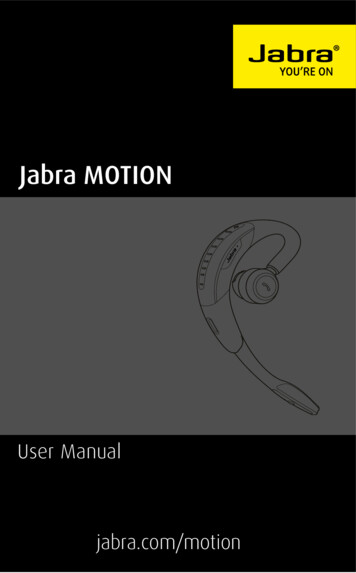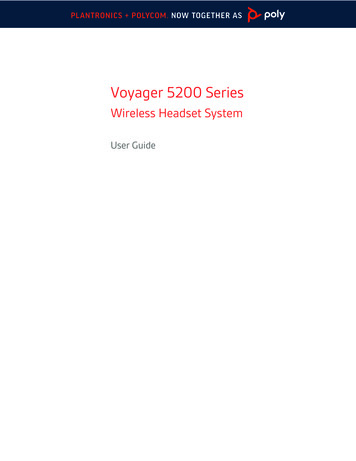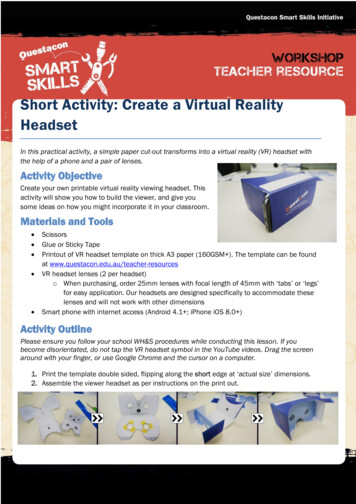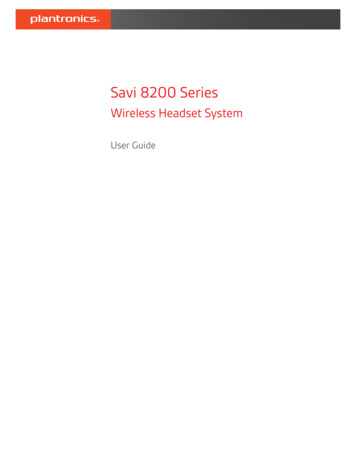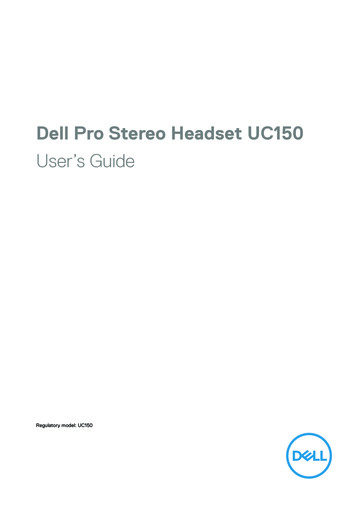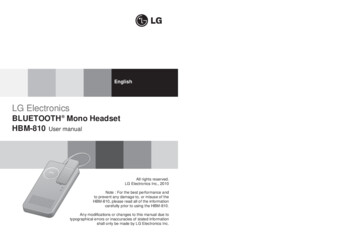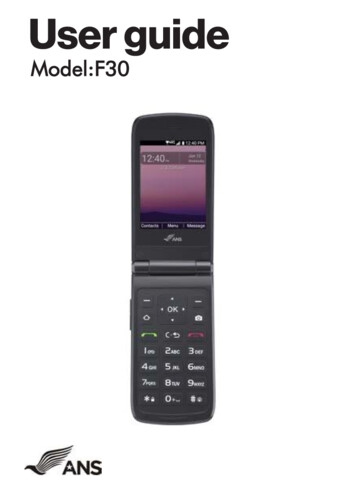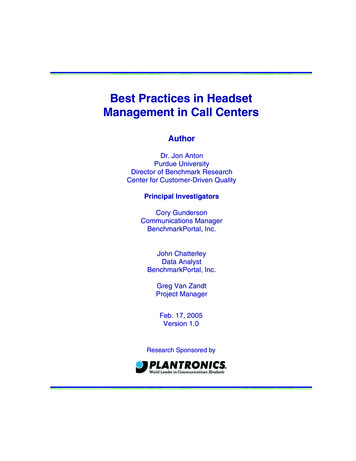
Transcription
Best Practices in HeadsetManagement in Call CentersAuthorDr. Jon AntonPurdue UniversityDirector of Benchmark ResearchCenter for Customer-Driven QualityPrincipal InvestigatorsCory GundersonCommunications ManagerBenchmarkPortal, Inc.John ChatterleyData AnalystBenchmarkPortal, Inc.Greg Van ZandtProject ManagerFeb. 17, 2005Version 1.0Research Sponsored by
Copyright 2005, BenchmarkPortal, Inc.This report may not be copied, scanned or reproduced without the written permission ofBenchmarkPortal, Inc. Additional copies may be purchased at a reasonable price bye-mailing Information@BenchmarkPortal.com or by calling (805) 614-0123 ext. 10.PU74-021705
Table of Contents123456Executive Summary .11.1 Purpose of Study .11.2 Summary of Key Research Findings .1Introduction .32.1 Introduction.3Best Practice Study Defined.5Research Objectives and Methodology.74.1 Objectives .74.2 Methodology .74.2.1 Survey One .74.2.2 Survey Two .8Best Practice Recommendations.95.1 Centralized Accountability for Headset Management .95.2 Headset Selection Process .95.3 Budgeting for the Purchase and Repair of Headsets .125.4 Agent Training in Headset Usage, Care, and Hygiene.135.5 Theft Deterrence .13Summary and Conclusion .157Selected Findings and Interpretations.177.1 Survey One.177.2 Survey Two.30About the Author.35About Plantronics .39Appendix A: Survey One Tabular Results.41Best in Class Practices of Headsets Management in Call Centers .41Appendix B: Survey Two Tabular Results.61Headset Management Costs in Call Centers .61References.65iCopyright 2005 BenchmarkPortal, Inc.
List of FiguresFigure 1. Industries represented by call centers participating in Survey One . 18Figure 2. Satisfaction with present headset management system. 19Figure 3. Reasons for purchasing new call center headsets . 20Figure 4. Percentage of participants purchasing new headsets during the pastyear. 21Figure 5. Reasons for selection of the particular brand of headset purchased . 22Figure 6. Percentage of call centers that measured call-handling statisticsbefore and after implementation of headsets . 23Figure 7. Headset training offered . 24Figure 8. Training offered on proper headset usage for monitoring of calls. 25Figure 9. Percentage of call centers with centralized headset management . 26Figure 10. Percentage replacement units on hand. 27Figure 11. Respondents’ rating of their current headset service provider. 28Figure 12. Likelihood to recommend the brand they use to other call centerprofessionals. 29Figure 13. Average price paid for a new wired headset . 31Figure 14. Average price per new wireless headset. 32Figure 15. Ratio of call centers that expense versus capitalize the cost of theirheadsets . 33Figure 16. Most important factor in deciding which brand of headset topurchase. 34iiCopyright 2005 BenchmarkPortal, Inc.
1 EXECUTIVE SUMMARY1.1Purpose of StudyThe purpose of this study was to document current best practices in headset managementin call centers. This study focused specifically on eplacementWhile the cost of even the highest quality headsets is low when compared with call centerstaff salaries, computer software, and telecom expenses, the mismanagement of headsetscan contribute to poor customer service, increased agent stress, and unnecessarybudgetary expense. And, yet, organizational accountability for this essential piece ofequipment and its related parts is sometimes loose at best in the fast-paced, pressurecooker environment of today’s call center.A primary driver of this study was our conviction that there is much more money at stakewhen headset management is neglected than busy call center leaders might realize. Oftenthe focus of call center cost reduction initiatives is the obvious—reducing agent turnover,increasing agent efficiency, upgrading technical capabilities to reduce wasted time, andthe like. The results of our study will illustrate that effective headset management is anoften-overlooked endeavor that will not only result in improved agent job satisfaction andincreased customer satisfaction—but in cost savings worth pursuing.1.2Summary of Key Research Findingsa. All respondents purchased headsets in 2004; 83% of respondents purchased newunits while the remainder purchased used.b. When it came to headset brand selection, 36.8% of survey respondents indicatedthat their choice was based on “quality, performance, and reliability;” this washigher than any other selection criteria, including price.c. Nine out of every ten respondents indicated that they felt comfortable with theircurrent headset service provider.d. Only slightly more than one-third of the centers are using current technologies(USB and Blue Tooth), and less than one half of the centers that use wirelessheadsets employ 2.4 GHz technology.e. About three-quarters of respondents indicated that they were “fairly satisfied” or“satisfied” with their present headset management systems.1Copyright 2005 BenchmarkPortal, Inc.
Best Practices in Headset Management in Call Centersf.Surprisingly, only 1 in 12 respondents offer their agents training in the hygienicuse of headsets.g. Training in the proper use and storage of headsets was somewhat better thoughstill surprisingly low.2Copyright 2005 BenchmarkPortal, Inc.
2 INTRODUCTION2.1IntroductionHeadsets were originally worn by telephone company operators who helped callers placelong distance connections. This was circa the early 1900s—before the term call center hadbeen coined. In those days, the headset was a large, cumbersome contraption that wasworn using an over-the-shoulder harness that placed a long, curved funnel-looking deviceface up in front of the operator. The earphones covered both ears. This technical wonderweighed more than ten pounds and depended on large, heavy, bolted-to-the-floor powersupplies to make it operable. Back then, both carbon microphones and ear speakersdepended upon large amounts of electrical current to run, and distortion ruled.In the late 1930s, carbon microphones (a.k.a. button mics) were introduced. They weresmaller and somewhat more comfortable than their predecessor but still required asignificant electrical current that, unfortunately, still created significant distortion.The advent of miniaturized hearing aides in the 1960s benefited not only the hard-ofhearing but those who depended on headsets to do their job, too. Headset makers placedinto the microphone and earpiece the same small circuits and tiny coils found in the minihearing aides. This redesign resulted in a much-improved one-pound headset that didn’trequire the heavy electrical components it had before. Distortion reduction, as well ascomfort, was greatly improved.The headset was further miniaturized and its performance enhanced in the 1970s. Theactors who played NASA technicians in the movie Apollo Thirteen sported these “minis,”which weighed only five ounces—a boldly go-where-no-man-had-gone before invention ofthat day.Today, headsets have literally gone “unplugged.” Though wired headsets still dominatetoday’s call centers, wireless units offer the independence from being tied to a telephonebase. Instead, they rely on rechargeable power supplies. The luxury of increased mobilitywithin the call center is certainly a lure for those leaders who want their supervisors,managers, and performance coaches to walk the floor and remain connected to theiragents and/or customers. They may also find them helpful for those agents who mustrepeatedly have access to remote fax machines and other remote job-help sources to dotheir work. Their higher cost and frequency limitations, however, remain as obstacles totheir wider use.Though headsets truly have come a long way, baby, their purpose in call centers remainsunchanged—to effectively connect someone who requires service to someone remotelylocated who can deliver it. And, while one could reason that the job of those dependent onheadsets to service customers should get increasingly easier with each new advance intechnology, today’s agents would likely confirm that their jobs are anything but easy.3Copyright 2005 BenchmarkPortal, Inc.
Best Practices in Headset Management in Call CentersConsider the current conditions in most call centers. Executives, under the gun to growtheir customer bases in the most cost effective ways possible, depend upon theirorganization’s call center staff to deliver loyalty-inducing service as efficiently as possible.And, as if that alone doesn’t feel like a mighty tall order, consider the number of“headsetted” agents squeezed into cubicles in close proximity to fellow agents—all tryingto respond effectively to a wide variety of customers who come in a wide variety of moods.Compounding the agents’ challenge of providing good service is the increased number ofcustomers who use cell phones to contact call centers. That means that agents aren’t justdealing with their own call center’s background racket —they’re also up against thestatic, interference, and background noise arising from the customer’s callingenvironment.With all this noise potential swirling around each service experience, it is likely thatagents are unwittingly increasing their own voice level. This cacophony is obviouslydetrimental to the entire service experience. Agents and customers may have to repeatthemselves to be heard, thus reducing the agent’s productivity and the customer’s level ofservice satisfaction.And every tenured call center leader knows that, considering the large volume ofcustomer calls their agents handle each shift, every second of inefficiency adds up to aconsiderable loss in profits. A benchmark that illustrates how time-sensitive a call centershould be is the following: In a center of 500 agents, if you can reduce the call handle timeby just one second per call, this equates to an annual savings of one full-time equivalentagent position.Consider not only the loss of agent efficiency but the increase in telecom costs, too, whenagents and customers have to repeat themselves. Previous studies we’ve conducted showthat each less-than-extremely-satisfied customer experience has the high potential totransform a current customer into a former customer.What this all adds up to is a clarion call for today’s call center leaders: Don’t ignore theimportance of something too easy to take for granted—headsets. More specifically,effective headset management systems. Consider the reading of this Best Practice Reportthe first step you take to better manage this invaluable resource.4Copyright 2005 BenchmarkPortal, Inc.
3 BEST PRACTICE STUDY DEFINEDDr. Anton’s team, referred to from this point forward as the “Team,” defines “bestpractices” as those planned workflow delivery steps that have proven to achieve thehighest effectiveness and efficiency for a given process. Best practices include thestrategy and operational implementation of articulated steps to deliver the defined endgoal of a given process.The Team uncovers best practices by gathering targeted information on specific callcenter processes and practices (in this case, on the topic of headset management) from awide variety of centers. Centers known for their effectiveness are the main source of theTeam’s research. The data gathering occurs through the use of comprehensive surveys,on-site visits, and telephone interviews. The Team documents those steps in the centers’implementation that have had a substantial impact on achieving and/or exceedingprocess end-goals.The concept of benchmarking to find best practices is simply described by the followingstatement:“All of us are smarter than any one of us.”What this means is that there is seldom one call center that is better in all areas than allothers. More typically, effective centers are doing one or more things really well but maybe unaware of the creativity and effectiveness of others. Our research discovers the bestpractices and makes them known to those interested in improving the effectiveness andefficiency of their center. This document is such a report of the best practices in headsetmanagement.Other best practice reports available through BenchmarkPortal include:a. Agent Monitoring and Coachingb. Workforce Managementc. Up-sell and Cross-sellPlease visit www.BenchmarkPortal.com for more information on ordering thesereports or call 805.614.0123 ext. 10.5Copyright 2005 BenchmarkPortal, Inc.
4 RESEARCH OBJECTIVES AND METHODOLOGY4.1ObjectivesThe main objective in conducting this study was to document best practices in headsetmanagement. Specifically, we believed that documentation of the best practices of thefollowing headset management practices would reveal ways call center leaders couldimprove the effectiveness and efficiency of their organizations:a.b.c.d.e.4.2Centralized accountability for headset managementHeadset selection processBudgeting for the purchase and repair of headsetsAgent training in headset usage, care, and hygieneTheft deterrenceMethodologyThe Team created two separate, but related, survey instruments to collect headsetmanagement practices information using consistent criteria.4.2.1 Survey OneThe first survey, ‘Best Practices in Headset Management in Call Centers’(Appendix A), was the more comprehensive of the two. It focused on gathering data on:the call center itself (e.g., industry served, number of call centers within organization,number of agents, etc.); headset brand and model used in the center; headset selectionand purchasing criteria; service management; storage and logistics management; andsatisfaction level with brand and distributor, etc.4.2.1.1Determination of Whom to Survey/Fielding the SurveyCall Centers that have been determined to be Centers of Excellence—both effective andefficient—were invited into this study. A variety of headset brand manufacturers werealso asked to provide us with the names of their largest product users for invitation intothe study. Those product users were also invited to participate.a. Twenty-five call centers responded to our invitation, completed the survey, andreturned their responses to us via e-mail.b. Ten in-depth follow-up telephone interviews were conducted to explore thespecifics related to the survey’s open-ended questions.c. Three on-site visits were conducted to observe and discover unique and effectiveprocesses as they pertained to headset management.7Copyright 2005 BenchmarkPortal, Inc.
Best Practices in Headset Management in Call Centers4.2.2 Survey TwoThe second survey, ‘Headset Budget and Selection’ (Appendix B), focused specificallyon headset selection criteria and headset budget matters.4.2.2.1Determination of Whom to Survey/Fielding the SurveyCall centers that are part of BenchmarkPortal’s community were sent invitations toparticipate in the survey.a. More than 2500 surveys were e-mailed to a randomly selected group, and over 300call center professionals responded to the survey, indicating a response rate of16%.8Copyright 2005 BenchmarkPortal, Inc.
5 BEST PRACTICE RECOMMENDATIONS5.1Centralized Accountability for Headset Managementa. It is considered best practice to centralize headset management accountability.Having headset procedures and systems in place will save you time and money.The goal is to eliminate the all too common practice of having headsets and partscrammed in boxes, stuffed under desks, scrapped in cabinets at the end of the hall,etc. In these less-than-ideal scenarios, whenever a headset breaks, someone has toleave the floor in hopes of retrieving a working unit. The result in lost time and anegative impact on performance metrics. The team member responsible forinventory should ensure that working headsets are always available and thosethat are not are quickly turned around for repair and/or return.b. Decide who will manage your headsets. In smaller call centers, the best practice isto assign a call center leader who can own the process and start to implementprocedures and be accountable for managing all headset-related inventory. Thisaccountability is a portion of the leader’s position description.c. In larger call centers (500 agents), managing headset-related inventory mayrequire a full-time person.d. Those centers that manage their headset inventory typically track headsets onthree different spreadsheets: 1) headsets in stock/available, 2) headsets waiting forrepair, and 3) headsets out for repair. Some manage their inventory electronically,while others choose to track theirs on paper.5.2Headset Selection Processa. Your business relies on clear, effective communications with your customers, andthe headset is the most important link between your agents and your customers.Selecting headsets, and a headset company, is an important decision for yourbusiness. A call center’s management team, with members from training and/orquality assurance, is typically given accountability for headset purchasingdecisions. This team’s responsibility is to research headset brands and modelfeatures and order several different ones. After agents have the chance to “testdrive” the headsets and critique them, the management team makes purchasingdecisions.b. When selecting new headsets, best practices include a thorough comparison ofheadset brands and models. Most centers typically buy one brand but have 2—3wearing styles available to accommodate agent wearing preferences and the callcenter environment. Typically, ordering one brand from one supplier results involume purchase discounts.9Copyright 2005 BenchmarkPortal, Inc.
Best Practices in Headset Management in Call Centersc. A thorough headset selection comparison should include addressing the followingissues to ensure you make the best selection choice for your center’s needs andbudget:i.Noise level. Determine your call center’s noise level so you can select theappropriate headsets. Does your vendor offer a complete line of headsetsavailable with both Voice Tube and Noise Canceling microphones? Investingin features that you may not need, or skimping on those you do, can leaveyou with headsets that don’t function well in your particular call centerenvironment.ii.Know your vendor. Consider your headset vendor as you would any othercritical business partner. Do they have the necessary experience? Do theyunderstand call centers? Can they support you throughout the sales andsupport process? Are they financially stable for the long term?iii.Product range. Does the vendor of choice offer a full range of products?Comfortable agents are productive agents, and there are many headset stylesto meet individual needs. It’s never a “one size fits all” situation. To increaseagent productivity and monitor customer satisfaction, choose a vendor thathas a cordless option for coaches or supervisors to move freely from agent toagent.iv.One supplier. Consider standardizing on one headset manufacturer andsupplier. When developing a call center, or looking to update your inventory,identify one solid supply chain that can meet all your needs. This will loweryour transaction costs, which can lower your overall cost of ownership.v.Inventory management. Be thorough in considering inventorymanagement. Where are you going to store and how do you keep track ofyour headset inventory? Identify a vendor that offers inventory managementsolutions.vi.Sales and support. Think about how your headsets will be serviced postsale. Make sure that you identify a headset supply chain that will provideyou 24-hour support. Having headsets work around the clock is crucial.Without headsets, agents don’t answer calls, and sales don’t get made.vii.Agent training. Remember that agents need training on how to use, carefor and maintain headsets. Trained agents will protect your headsetinvestment. Some vendors provide onsite training, computer-based training,training videos and interactive tutorials.viii. The sound of the future. Consider if your manufacturer is continuing toinvest R&D dollars in the call center. The headset is the last link betweenagents and customers; it should provide superior sound quality, fit, comfort,and stability, allowing agents to focus on calls and close sales, rather thanbeing hassled by inadequate headsets.10Copyright 2005 BenchmarkPortal, Inc.
Best Practice Recommendationsix.Determine what you’re getting for your money. Due diligence requiresthat you compare not only one headset price to others but ensure that youare buying the best value your center can afford. The cheapest headset willseldom prove to be the best value. Don’t forget to consider each headset’sability to deliver the kind of service your customers expect while managing tobudget.x.Determine if the sound quality heard by both the agent and thecustomer is strong and clear.xi.Determine if the headset will be comfortable for a call center agentto wear for a full shift.xii.Ensure the headset offers a snug fit that will stay in place.xiii. Be sure the volume controls can be adjusted easily and offer anadequate range of control.xiv. If you are considering the purchase of a wired headset, ensure thecord is long enough to allow adequate agent movement.xv.Be sure the quick disconnect is truly quick and easy. And ensure theagent can reconnect without hassle. Without an effective quick disconnectsystem, agents might not have ready access to remote consulting sources. Ifthe agent has to hang up on callers and call them back later, she is not onlyincreasing her Average Work Time (AWT) but is incurring unnecessarytelecom charges, too.xvi. Determine if binaural (both ears) or monaural (one ear) headsets aremore appropriate for your agents. If your agents seldom have the need toconsult with others in their call center, binaural headsets may be the betterchoice because they increase call clarity. Monaural headsets will likely bemore effective for those agents who depend more heavily on the consultationof other team members within their call center.xvii. Check to see if the microphone is easy to adjust and one that won’tget in the agent’s way.xviii. If your center is considering going wireless, consider the userdensity of your center. Ask yourself: What is our building’s layout andemployee distribution within this space? User density refers to the number ofwireless units that can be used in one space before interference beginsbetween those units. This can be a critical issue in environments where alarge number of employees use wireless units within close proximity of eachother.xix. If your center utilizes wireless headsets or is consideringpurchasing them, ensure the supplier offers a money back guaranteeon security and density. This offers greater assurance against11Copyright 2005 BenchmarkPortal, Inc.
Best Practices in Headset Management in Call Centerstransmission interference. This reduces the occurrence of cross talk (whenone receiver picks up the conversation of another transmitter).xx.Check to see if the headsets you’re considering are compatible withUSB (Universal Serial Bus). USB is a high-speed digital connectiondirectly into your PC. The USB connector is now ubiquitous, as it has beenincluded on virtually every PC sold over the past several years. Connecting aheadset via a PC’s USB port allows you to bypass the sound card entirely,resulting in a cleaner, stronger signal. Headsets are currently available thatutilize the USB port of an agent’s workstation commonly used in VoIPapplications.Some advanced USB types of headsets have remote call detection andanswer/end capability utilizing specialized software that produces superiorsound quality.5.3Budgeting for the Purchase and Repair of Headsetsa. Analyze your headset expenses over a two to four year period – not just upfrontpurchase price. The purchase price accounts for only half of the costs over time.Repairs, spare parts, shrinkage, mismanaged inventories, and warrantiescomprise the remainder of the expenses. Identify all costs up front so you have acomplete picture of your financial investment.b. Seventy-one percent of respondents to Survey Two indicate that their call centersconsider headset and related purchases as expense items, rather than capitalizeditems.c. Almost 90% of call centers in Survey Two report that they spend less than 5,000per year on headset repair/replacement.d. Of the call centers who responded to Survey Two, 71% reported that they paybetween 51 - 150 per new wired headset.e. Only 34.5% of the call centers that responded to Survey Two indicate that they usewireless headsets. Of this group, over 90% indicate that they pay between 101 tomore than 200 per wireless unit.f.It is considered best practice to maintain a separate budget for headset repair andreplacements. Expenses are more easily monitored and managed this way.g. Best practice is to secure a service guarantee from the headset distributor thatpromises to send out a replacement headset before receiving the damaged unit.h. Best practice is to turn in damaged, out-of-warranty headsets for a credit towardsthe purchase of new units.12Copyright 2005 BenchmarkPortal, Inc.
Best Practice Recommendations5.4Agent Training in Headset Usage, Care, and Hygienea. While the number of call centers that provide agents training on headset cleaningand hygiene, proper storage, and usage was disappointingly low, best in practicecenters provide this education in initial training. Further, during the cold and fluseason, these centers offer agents e-mail refreshers on headset cleaning andhygiene.b. Best in practice centers advise agents returning from sick leave to turn in theirheadset for a refurbished, clean unit. The headsets that are turned in are sprayedwith an antiseptic and thoroughly cleaned with alcohol wipes before beingreassigned.c. Some best in practice centers offer agents replacement earmuffs and alcohol wipesfor a nominal fee via vending machines within the call center.d. One best practice center cut cost on disinfectant wipes by discontinuing their useof pre-packaged ones in favor of “home made” wipes. Call center leaders purchasein bulk Kimberly Clark paper towels and Top Job industrial-use antibacterialpowder. Leaders then make their own disinfectant wipes for a fraction of whatthey had been paying for the ready-made ones.e. Another best practice is to provide agents headset pouches for storage when theirheadsets are not in use (overnight and throughout extended time away from thecall center). These pouches are then stored in locked file drawers, lockers, orcabinets. This practice not only reduces the risk of spreading germs and infectionsbut also protects units from damage and theft.5.5Theft Deterrencea. Wh
Best practices include the strategy and operational implementation of articulated steps to deliver the defined end-goal of a given process. The Team uncovers best practices by gathering targeted information on specific call center processes and practices (in this case, on the top
